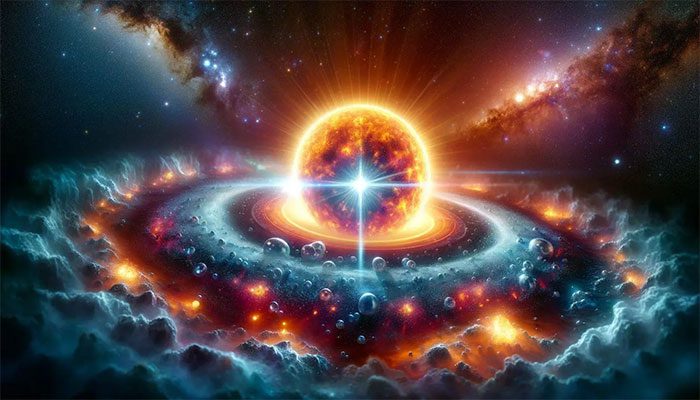In a region of deadly space, filled with ultraviolet light and other harsh cosmic rays, the precursors to life are emerging.
The world’s most powerful space telescope, the James Webb Space Telescope, has just captured signals of numerous precursors to life located 5,500 light-years away from Earth, a discovery that promises to explain the origins of our own existence.
Surrounded by extreme, toxic cosmic rays, the “death zone” NGC 6357 is, in fact, a stellar nursery.

Graphic depicting a young star with a protoplanetary disk that may contain precursors to life – (Image: SCITECH DAILY).
Inside it are more than 10 large, brilliantly shining stars showering UV rays onto many young stars still surrounded by their protoplanetary disks.
And one of those protoplanetary disks contains clear signs of water and organic compounds.
According to a study on NGC 6357 recently published in the Astrophysical Journal Letters, the findings from James Webb suggest that Earth-like planets can form even under harsh conditions.
This is because the precursors to life have been shown to exist even within the protoplanetary disk of our Sun.
When a planet is fortunate enough to form within the habitable zone, like Earth, the “seeds” of oceans and life will combine with additional materials brought in by comets and asteroids, thus forming a world as we know it today.
According to the research team led by Dr. María C. Ramírez-Tannus from the Max Planck Institute for Astronomy (MPIA), this star’s protoplanetary disk also contains other elements indicating the potential for rocky planets like Earth to emerge.
This disk is named XUE-1, exposed to the high-intensity ultraviolet radiation from nearby large, hot stars.
The existence of water and organic molecules despite the harsh conditions is an intriguing surprise, suggesting that our own ancestors may have also developed in such an extreme interstellar environment.
According to SciTech Daily, more than half of the stars in our universe are born within massive star-forming regions along with their planets.
Previously, scientists were concerned that extreme radiation could hinder the conditions necessary for star and planet formation, as well as the emergence of life’s precursor molecules.
However, this discovery shows that life has many ways to infiltrate and survive in the most extreme environments, meaning that the number of Earth-like planets with potential for life may be greater than we imagine.


















































